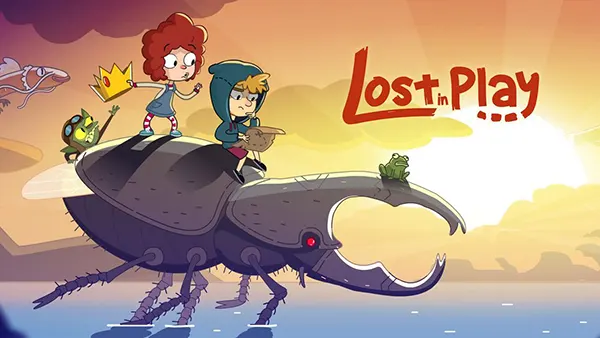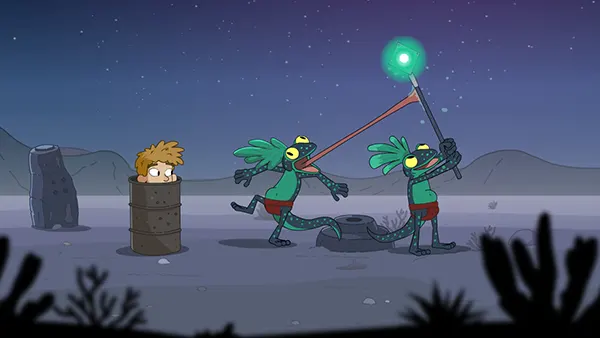
Lost in Play – Animated Puzzle Adventure for All Ages
“Lost in Play” is a unique adventure game that combines point-and-click mechanics with hand-drawn cartoon aesthetics. Released by Happy Juice Games, this title has captured the attention of players worldwide thanks to its imaginative world, seamless animation style, and brain-teasing puzzles. It is available across PC, Nintendo Switch, iOS, and Android, making it highly accessible for players of different preferences. With no dialogue and a universal visual language, the game is suitable for children and adults alike.
Visual Design and Atmosphere
One of the most striking features of “Lost in Play” is its visual identity. The game draws heavy inspiration from animated series like “Gravity Falls” and “Over the Garden Wall”, resulting in a nostalgic yet fresh experience. The backgrounds are crafted with exceptional attention to detail, and every scene looks like it belongs in a professionally animated series.
The animation quality is a standout aspect. Characters move fluidly with expressive body language, compensating for the absence of spoken language. The whimsical creatures and imaginative settings contribute to a fairy-tale atmosphere that remains engaging from start to finish.
Lighting, shadows, and transitions between locations are executed with cinematic finesse. This creates an immersive environment where players feel like they are progressing through a fantastical journey with real stakes and emotional depth.
Soundtrack and Audio Elements
The musical score enhances the gameplay without overpowering it. Light piano notes, ambient sounds, and whimsical melodies accompany each scene, adapting subtly to changes in gameplay tone. Despite the absence of voiceovers, the characters use expressive gibberish and sound effects to convey emotion and meaning effectively.
Environmental audio – from rustling leaves to the gentle creak of old wood – enriches the setting and reinforces the tactile feel of the game. It’s a rare instance where silence plays a vital role in building the emotional landscape.
Each puzzle has unique sound cues that provide non-verbal hints, guiding the player naturally without ever breaking immersion. This technique reflects a high level of design maturity and accessibility consideration.
Puzzle Design and Gameplay Mechanics
“Lost in Play” offers a balanced mixture of logic puzzles, pattern recognition, and item-based quests. The game avoids repetition by constantly introducing new mechanics as the story progresses. Players guide a brother and sister duo through a dreamlike world, solving problems using intuition and careful observation.
Puzzles are designed with players of all ages in mind. They are challenging but never unfair. There is no time pressure or fail state, allowing players to explore freely and learn through trial and error. The absence of textual instructions also removes language barriers, making the game globally accessible.
Inventory and interaction systems are intuitive. The interface remains minimalistic, ensuring that the screen remains uncluttered and that the focus stays on the characters and environments. Hints are contextual and visual, preserving the immersion throughout.
Story Progression and Symbolism
While the game lacks a traditional script, its narrative is deeply engaging. The story is told through symbolic visual sequences and character interactions. Themes such as childhood imagination, sibling bonds, and self-discovery are gently woven into the gameplay.
Each chapter represents a unique environment, such as underwater kingdoms or eerie forests, reflecting the emotional states of the characters. These symbolic locations serve as metaphorical challenges and milestones in the siblings’ growth.
The transitions between dream and reality are handled with care, often blurring the line between the two. This storytelling method adds depth and encourages the player to reflect on the meaning of each episode in the siblings’ journey.

Reception, Accessibility and Future Prospects
As of June 2025, “Lost in Play” continues to receive positive reviews from critics and players alike. It holds a score of over 85% on Metacritic and is praised for its artistic innovation, cross-generational appeal, and accessibility features. With its success on mobile platforms in 2024, the game has reached a wider audience.
Accessibility-wise, it offers colourblind-friendly design, simplified controls, and no need for reading. This makes it particularly suitable for younger children and players with cognitive or motor impairments. The inclusion of skip options for puzzles ensures that no user is left behind due to difficulty.
There is growing anticipation around a possible sequel or additional content. The development studio has hinted at new projects in a similar visual style, potentially expanding the world of “Lost in Play”. As it stands, the game is a benchmark for how interactive storytelling and visual design can elevate the puzzle genre.
Educational and Creative Impact
Educators and parents have noted the game’s value in developing cognitive skills. Puzzle-solving encourages logical thinking, while the story fosters empathy and emotional intelligence. It has been incorporated into some school curricula as an example of gamified learning.
For aspiring game designers, “Lost in Play” serves as a reference for visual storytelling without reliance on dialogue. It shows how creativity can bridge linguistic and cultural divides, inspiring young creators to think beyond conventional narrative forms.
The game’s success has also revitalised interest in 2D animation within the indie scene. Its commercial and critical performance proves that there is still a market for hand-drawn, heartfelt experiences in the age of photorealistic 3D titles.
